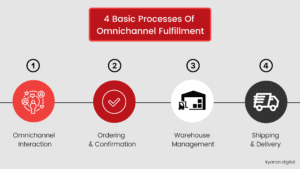Omnichannel fulfillment is one of the best ways to enable businesses to meet those demands of modern consumers as well as to appeal to them. For many years, the traditional channel brick-and-mortar retail model meant that fulfillment processes were fairly straightforward. Gradually, things might not work effectively, for example when a store is out of stock of the clothes your customer wanted in their size, the retailer would lose the sale.
These days, retailers approach consumers through multiple channels both in-store and digital hoping to provide a personalized experience to modern consumers who have certain expectations when it comes to shopping and receiving orders. They want instant gratification, which means easy and quick access to products, both in-store and online, to use technology to make purchases with the swipe of a finger and to have their parcels delivered to their doorstep the same day or very next day. So, what is omnichannel fulfillment?
1. Omnichannel Fulfillment
We can define omnichannel as the synchronized and consistent use of different channels to sell goods and services to consumers. A well-structured omnichannel fulfillment enables them to buy whatever, whenever, wherever. The goal of this fulfillment strategy is to reduce costs, make the buying process go smoothly, and satisfy the customer’s experience. Omnichannel fulfillment obtains these goals through four basic processes:

1.1. Omnichannel Interaction
This is where you interact with your customers the benefits of using your omnichannel fulfillment service. Provide them the promise of a seamless experience through different platforms and services.
1.2. Ordering and Confirmation
The main point that appeals to consumers of this step compared to the standard order confirmation process is that they can place an order on a mobile device, choose a shipping option that they want to pay, and know exactly when it will be delivered.
1.3. Warehouse Management
The process is where orders are actually filled in real-time. Different from traditional methods of fulfillment, these extra channels provide much needed flexibility and ensure your customers get what they want, when they want it while keeping you compliant with your vendors.
1.4. Shipping & Delivery
Shipping is the fourth process in omnichannel fulfillment but also one of the most important, as it utilizes advanced shipping software to satisfy consumers by letting them be able to track the shipping status.
As effective as omnichannel fulfillment is at allowing companies to synchronize inventory, logistics and distribution functions across all sales channels to meet consumer demand, it comes with its own unique set of challenges that retailers need to take time to understand to refine their implementation strategies to overcome issues and excel in the omnichannel space.
2. Top 7 Challenges Omnichannel Fulfillment

2.1. Order Management
Order management is a crucial step in order to create a smooth and profitable operation. The number of factors that are at stake in an omnichannel system make it difficult to arrange the dispatch method; this leads to possibility of backorders, unsatisfied customers, and high costs.
Traditional order management systems operate on a single channel with limited inventory visibility, and they lack the capacity to support a multi-platform operation with different delivery options. This is problematic because the new role of stores as order fulfillment centers is excluded from the operation and compromises delivery fulfillment.

Source: Vardells
2.2. Lack of Inventory Visibility and Metrics
Omnichannel fulfillment is supposed to bridge the gap between online and brick-and-mortar stores. It helps consumers experience a smooth transition from one channel to another, and it also requires thousands of changes to inventory management, order processing and operations. And the changes of inventory management may lead to visibility issues.

Source: CrmViet
2.3. Poor Visibility Into Inventory in Transit
Most retailers, both major enterprises and startups alike, generally have relatively poor visibility into inventory in transit, which has led to an increasing need for real time freight visibility solutions. Leading omnichannel fulfillment solutions not only enable visibility into shipments and deliveries, but also into orders and stock-tracking units. These solutions combine optimization and collaboration capabilities that facilitate communication and the exchange of data and information.

Source: Conveyco
2.4. Warehouse management
Applying omnichannel fulfillment brings with it a great number of challenges within the operation of the distribution centers. In many cases, operations depart from a cross dock system, where whole pallets are sent to stores, to a system where orders also include pieces for final consumers. As a result, companies need to update their Warehouse Management Systems (WMS) to simultaneously streamline store replenishment and be able to process online orders placed by end consumers.

Source: SkuVault
2.5. Lack of Value-Added Services Exist
Simply explained, value-added services are provided by third parties or vendors in order to add an extra level of efficiency to order management, for example: automating labeling, improving carton allocation and packing, and ensuring proper shipping and invoice generation. These services help reduce costs, improve cycle times and enhance omnichannel processes across multiple distribution centers and shipping-enabled retail stores. Therefore, lacking any one of these necessary valued-added services might lead to the delay for the operations, and affect negatively on consumers’ shopping experience.

Source: snowmicro
2.6. Single Channel Returns Management Requires More Work
Different from standardized processes and multi-site distribution centers, returns management in an omnichannel supply chain must be cross-channel. That means consumers purchasing an item online should have the option of returning it directly at the store or by shipping. In order to make it convenient, omnichannel retailers may implement on-demand, at-home label printing for consumers or include a return label in the original packaging. By doing that, companies create a consistent experience across their website, app, and brick-and-mortar locations. Failure in any part of the returns management system within the omnichannel fulfillment may lead to the loss of customers.

Source: Matchman Supplies
2.7. Customer interaction
It may seem unnecessary to build and maintain a good relationship with shoppers who only interact with you via an online store or Marketplace. However, the foundation of a successful omnichannel approach lies precisely in building strong relationships with customers through personalized and satisfying shopping experiences. This will later translate into more sales and greater customer retention.

Source: The Retail Doctor
To meet modern expectations of the omni-customers, retailers need to create new planning and fulfillment methods to enable convenient, predictive, and cost-effective deliveries to their customers. Retailers need to come with good solutions for those above challenges, and they have to cover all angles. And the companies that want to stand out and survive will be those who keep up with the best technological tools, streamline their processes, and offer enough flexibility to meet new consumer trends. All these require a ton of work if your company has to go by itself. Therefore, finding a good partner who can give the best advice to boost up your own distinctive business is the best solution. Contact Kyanon Digital immediately, and we will show you how to get started.


